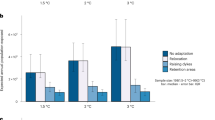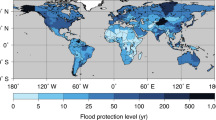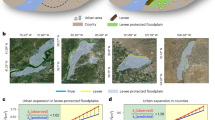Abstract
Floods cause billions of dollars of damage each year1, and flood risks are expected to increase due to socio-economic development, subsidence, and climate change2,3,4. Implementing additional flood risk management measures can limit losses, protecting people and livelihoods5. Whilst several models have been developed to assess global-scale river-flood risk2,4,6,7,8, methods for evaluating flood risk management investments globally are lacking9. Here, we present a framework for assessing costs and benefits of structural flood protection measures in urban areas around the world. We demonstrate its use under different assumptions of current and future climate change and socio-economic development. Under these assumptions, investments in dykes may be economically attractive for reducing risk in large parts of the world, but not everywhere. In some regions, economically efficient investments could reduce future flood risk below today’s levels, in spite of climate change and economic growth. We also demonstrate the sensitivity of the results to different assumptions and parameters. The framework can be used to identify regions where river-flood protection investments should be prioritized, or where other risk-reducing strategies should be emphasized.
This is a preview of subscription content, access via your institution
Access options
Access Nature and 54 other Nature Portfolio journals
Get Nature+, our best-value online-access subscription
$29.99 / 30 days
cancel any time
Subscribe to this journal
Receive 12 print issues and online access
$209.00 per year
only $17.42 per issue
Buy this article
- Purchase on Springer Link
- Instant access to full article PDF
Prices may be subject to local taxes which are calculated during checkout




Similar content being viewed by others
References
Munich, Re NatCatSERVICE Database (Munich Reinsurance Company, Geo Risks Research, 2013).
Hirabayashi, Y. et al. Global flood risk under climate change. Nat. Clim. Change 3, 816–821 (2013).
Winsemius et al. Global drivers of future river flood risk. Nat. Clim. Change 6, 381–385 (2016).
Arnell, N. W. & Gosling, S. N. The impacts of climate change on river flood risk at the global scale. Climatic Change 134, 387–401 (2014).
Jongman, B. et al. Declining vulnerability to river floods and the global benefits of adaptation. Proc. Natl Acad. Sci. USA 112, E2271–E2280 (2015).
Ward, P. J. et al. Assessing flood risk at the global scale: Model setup, results, and sensitivity. Environ. Res. Lett. 8, 044019 (2013).
Winsemius, H. C. et al. A framework for global river flood risk assessments. Hydrol. Earth Syst. Sci. 17, 1871–1892 (2013).
UNISDR Global Assessment Report on Disaster Risk Reduction. Making Development Sustainable: The Future of Disaster Risk Management (United Nations International Strategy for Disaster Reduction Secretariat, 2015).
Ward, P. J. et al. Usefulness and limitations of global flood risk models. Nat. Clim. Change 5, 712–715 (2015).
Towards a World of Cities in 2050. An Outlook on Water-Related Challenges (Netherlands Environmental Assessment Agency PBL, 2014).
Sadoff, C. W. et al. Securing Water, Sustaining Growth: Report of the GWP/OECD Task Force on Water Security and Sustainable Growth (Univ. Oxford, 2015).
Aerts, J. C. J. H. et al. Evaluating flood resilience strategies for coastal megacities. Science 344, 473–475 (2014).
Kind, J. M. Economically efficient flood protection standards for the Netherlands. J. Flood Risk Manag. 7, 103–117 (2014).
Kull, D., Mechler, R. & Hochrainer-Stigler, S. Probabilistic cost-benefit analysis of disaster risk management in a development context. Disasters 37, 374–400 (2013).
Scussolini, P. et al. FLOPROS: an evolving global database of flood protection standards. Nat. Hazard Earth Sys. 16, 1049–1061 (2016).
VanVuuren, D. P. et al. The representative concentration pathways: an overview. Climatic Change 109, 5–31 (2011).
O’Neill, B. C. et al. A new scenario framework for Climate Change Research: the concept of shared socioeconomic pathways. Climatic Change 122, 387–400 (2014).
Sperna Weiland, F. C., Van Beek, L. P. H., Kwadijk, J. C. J. & Bierkens, M. F. P. Global patterns of change in discharge regimes for 2100. Hydrol. Earth Syst. Sci. 16, 1047–1062 (2012).
Sampson, C. C. et al. A high-resolution global flood hazard model. Wat. Resour. Res. 51, 7358–7381 (2015).
Trigg, M. A. et al. The credibility challenge for global fluvial flood risk analysis. Environ. Res. Lett. 11, 094014 (2016).
Alfieri, L., Feyen, L., Dottori, F. & Bianchi, A. Ensemble flood risk assessment in Europe under high end climate scenarios. Glob. Environ. Change 35, 199–212 (2015).
Di Baldassarre et al. Socio-hydrology: conceptualising human-flood interactions. Hydrol. Earth Syst. Sci. 17, 3295–3303 (2013).
Pappenberger, F. et al. The monetary benefit of early flood warnings in Europe. Environ. Sci. Policy 51, 278–291 (2015).
Van Wesenbeeck, B. K., de Boer, W., Narayan, S., van der Star, W. R. L. & de Vries, M. B. Coastal and riverine ecosystems as adaptive flood defences under a changing climate. Mitig. Adapt. Strateg. Glob. Change http://dx.doi.org/10.1007/s11027-016-9714-z (2016).
Hallegatte et al. Shock Waves: Managing the Impacts of Climate Change on Poverty (World Bank, 2016).
Koks et al. Integrated direct and indirect flood risk modeling: development and sensitivity analysis. Risk Anal. 35, 882–900 (2015).
Jonkman, S. N., Vrijling, J. K. & Vouwenvelder, A. C.W. M. Methods for the estimation of loss of life due to floods: a literature review and a proposal for a new method. Nat. Hazards 46, 353–389 (2008).
Jonkman, S. N. Advanced flood risk analysis required. Nat. Clim. Change 3, 1004 (2013).
Van Beek, L. P. H., Wada, Y. & Bierkens, M. F. P. Global monthly water stress: I. Water balance and water availability. Wat. Resour. Res. 47, W07517 (2011).
Wada, Y., Van Beek, L. P. H. & Bierkens, M. F. P. Nonsustainable groundwater sustaining irrigation: A global assessment. Wat. Resour. Res. 48, W00L06 (2012).
Weedon, G. P. et al. Creation of the WATCH Forcing Data and its use to assess global and regional reference crop evaporation over land during the twentieth century. J. Hydrometeorol. 12, 823–848 (2011).
Hempel, S., Frieler, K., Warszawski, L., Schewe, J. & Piontek, F. A trend-preserving bias correction - the ISI-MIP approach. Earth Syst. Dynam. 4, 219–236 (2013).
Yamazaki, D., Kanae, S., Kim, H. & Oki, T. A physically based description of floodplain inundation dynamics in a global river routing model. Wat. Resour. Res. 47, W04501 (2011).
Dottori, F. et al. Development and evaluation of a framework for global flood hazard mapping. Adv. Wat. Res. 94, 87–102 (2016).
Pappenberger, F., Dutra, E., Wetterhall, F. & Cloke, H. L. Deriving global flood hazard maps of fluvial floods through a physical model cascade. Hydrol. Earth Syst. Sci. 16, 4143–4156 (2012).
Alfieri, L. et al. Global projections of river flood risk in a warmer world. Earth’s Future 5, 171–182 (2017).
Klein Goldewijk, K., Beusen, A., Van Drecht, G. & De Vos, M. The HYDE 3.1 spatially explicit database of human-induced global land-use change over the past 12,000 years. Glob. Ecol. Biogeogr. 20, 73–86 (2011).
Van Vuuren, D. P., Lucas, P. L. & Hilderink, H. Downscaling drivers of global environmental change: enabling use of global SRES scenarios at the national and grid levels. Glob. Environ. Change 17, 114130 (2007).
Bouwman, A. F., Kram, T. & Klein Goldewijk, K. Integrated Modelling of Global Environmental Change. An Overview of IMAGE 2.4 (PBL Netherlands Environmental Assessment Agency, 2006).
Jongman, B., Ward, P. J. & Aerts, J. C.J. H. Global exposure to river and coastal flooding: long term trends and changes. Glob. Environ. Change 22, 823–835 (2012).
Ward, P. J. et al. Strong influence of El Niño Southern Oscillation on flood risk around the world. Proc. Natl Acad. Sci. USA 111, 15659–15644 (2014).
Aerts, J. C. J. H., Botzen, W. & De Moel, H. Cost estimates of flood protection and resilience measures. Ann. New York Acad. Sci. 1294, 39–51 (2013).
Jonkman, S. N., Hillen, M. M., Nicholls, R. J., Kanning, W. & Van Ledden, M. Costs of adapting coastal defences to sea-level rise—New estimates and their implications. J. Coast. Res. 29, 1212–1226 (2013).
Lenk, S., Rybski, D., Heidrich, O., Dawson, R. J. & Kropp, J. P. Costs of sea dikes—regressions and uncertainty estimates. Nat. Hazard. Earth Sys. 17, 765–779 (2017).
Bos, A. J. Optimal Safety Level for the New Orleans East Polder. A Preliminary Risk Analysis (VU University Amsterdam, 2008).
De Grave, P. & Baarse, G. Kosten van maatregelen. Informatie ten behoeve van het project Waterveiligheid 21e eeuw (Deltares, 2011).
The 2009 Global Construction Cost and Reference Yearbook (Compass International Consultants, 2009).
Ward et al. Partial costs of global climate change adaptation for the supply of raw industrial and municipal water: a methodology and application. Environ. Res. Lett. 5, 044011 (2010).
Acknowledgements
The research leading to these results received funding from the Netherlands Organisation for Scientific Research (NWO) in the form of a VIDI grant (grant no. 016.161.324) and the Aqueduct Global Flood Analyzer project, via subsidy 5000002722 from the Netherlands Ministry of Infrastructure and the Environment. The latter project is convened by the World Resources Institute. J.C.J.H.A. and W.J.W.B. received additional funding from the NWO in the form of VICI and VIDI Grants (grant no. 453.14.006 and 452.14.005). We thank O. Wing and M. Trigg for providing benchmarking inundation maps.
Author information
Authors and Affiliations
Contributions
All authors conceived and designed the experiments and contributed to discussions on, and writing of, the paper. P.J.W., B.J., P.S. and H.C.W. performed the experiments. P.J.W., A.D.L., P.S. and H.C.W. analysed the data. P.D.B. contributed to the benchmarking exercise.
Corresponding author
Ethics declarations
Competing interests
The authors declare no competing financial interests.
Supplementary information
Supplementary Information
Supplementary Information (PDF 7027 kb)
Supplementary Information
Supplementary Information (ZIP 135508 kb)
Rights and permissions
About this article
Cite this article
Ward, P., Jongman, B., Aerts, J. et al. A global framework for future costs and benefits of river-flood protection in urban areas. Nature Clim Change 7, 642–646 (2017). https://doi.org/10.1038/nclimate3350
Received:
Accepted:
Published:
Issue Date:
DOI: https://doi.org/10.1038/nclimate3350
This article is cited by
-
Financial constraints and short-term planning are linked to flood risk adaptation gaps in US cities
Communications Earth & Environment (2024)
-
Flood teleconnections from levees undermine disaster resilience
npj Natural Hazards (2024)
-
Flood insurance is a driver of population growth in European floodplains
Nature Communications (2023)
-
Cost-effective adaptation strategies to rising river flood risk in Europe
Nature Climate Change (2023)
-
Substantial increase in future fluvial flood risk projected in China’s major urban agglomerations
Communications Earth & Environment (2023)



